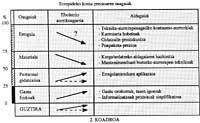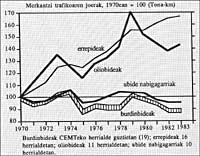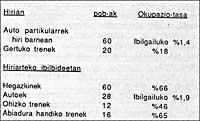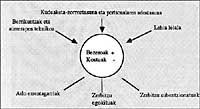Railroad and competitors: Year 2000 challenges
AIRCRAFT
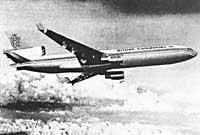
All airlines, like others, have as objective the productivity, or in other words, the benefit. After the expansion and transformation of the glorious years that have been taking place worldwide, there was a sharp increase in the prices of fuels, which, as is known, represents 30% of the production costs. According to figures recently published by the ICAO on 1972-82, traffic has doubled in 10 years (Table 1), but:
- Flight hours have only risen by 12%.
- Not all company resources have risen above 18%. (Flight staff has risen by 35%)
- The productivity of the aircraft increases by 40%.
Thus, airlines have also tested the current crisis, both in the field of the technical advances of the material, as well as in the exploitation and organization of networks or in the failed resources for not having done so, as well as in the competitions that have been worked in depth.
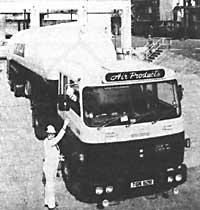
This is: When today the planes know if they use rates below their actual cost of exploitation.
Airlines show optimism for the next decade. On the one hand, they expect an increase of traffic of 7% and on the other, the decrease of costs is due to the fact that the reactors announce reductions of consumption of 20-30% of the motors.
These advances, are they a threat to the railways?. It also responds to some issues. For international passengers, probably yes. The bed wagon is already in danger and not anywhere, even in countries like Japan and France that are currently at high speeds, or in the DRF (Federal Republic of Almania), Italy, etc. They will circulate tomorrow.
The plane fare can be converted into a beacon for the railroad, as it does in the most active seasons of the year, if it offers discounts. Here, chaining the transports in the spiral for seasons and in the schedules, and the general consequence of these offers is to give a charge to the demand.
HIGHWAYS ROADS
In the decade 1960-70 the productivity of road transport increased considerably. There was a boom in road transport. But, will this type of transport continue to grow? The truth is that there are not many clear and clarifying data and we will have to analyze the four factors that influence the cost. These factors are:
- Fixed expenses (insurance, tolls,...)
- Personal staff
- Fuels Fuels Fuels Fuels Fuels
- Material (maintenance and innovation)
The evolution of these elements will be the key to the competitiveness of road transport. The future observed is shown in Table 2. Facing the picture, the truth is that it is difficult to make a concrete forecast. However, it seems that the tendency is to keep it or upload it a little.
TRANSPORT BY CHANNELS
As for transport in Ubideta, it cannot be denied that this is an economic transport system, although the concept of water tariff is still quite overcast: Who pays for infrastructure and how does it affect costs? The answer will probably vary from one country to another. The crisis that has hit the interior navigation, at least in all Europe, is both structural (profound changes in the energy production sector) and also accidental (steel and construction crisis).
It is given a relatively large surplus in the offers of cargo regarding those of freight (15-20% !). However, if you take into account that the vast majority of shipping companies (80%) do not have more than one boat, it is easy to think that prices are applied below, much below public rates. In these conditions the competition is practically null. The European interior navigation, conventional and enough to continue living: Is a plan to revitalize infrastructure planned?. In any case, the solutions of the intersection Rhin/Danube (1.990? ), will deeply transform the international market.
RAILROAD
The instruments of the railways to respond to the challenges of the competition can be divided into the following sections:
- Infrastructures and infrastructures Infrastructures
- Circulation or circulating material
- Environment Environment Environment
- Organisation of transport
- Management Management Management
A) Infrastructure
In this area, to date, railway infrastructures have been underutilized. The current situation can admit more traffic and also the investments made have been very limited. Little has been worked on improving the itineraries.
The improvement of the routes entails a great increase of the speeds, while the rearrangement of the signaling and the constant modification of the network of the rails allows an increase of the load and the galibo of each axis. This would also mean an increase in speed. However, the physical speed limit on the mixed tracks (cargo + passengers) is 200 km/h in locations with good infrastructure: Great Britain, France, Federal Germany and the Soviet Union. In these territories factors are given in favor of the great speeds, flat territories and curves of great radio. Disadvantage of mixed traffic.
The high loads damage the railway, so it is not possible to use high speeds. The experiences carried out in the US carry it at least. In the future, one could think of the distribution of specialized railways, some for passenger traffic and others for freight traffic. This proposal implies a risk of capacity, since it is known that the capacity of a line is affected by the difference of speed of circulation and even more by the functions of the trains that use it. This is one of the reasons why the European railway network has decided to arrive as soon as possible to the limit of 100 km/h with the freight trains.
B) Circulating material

The circulating material absorbs an average of half of the investments of the sectors and the railroad incorporates decisive elements for its competitiveness with other modes of transport.
On the other hand, and it must also be said, it is the one that most takes advantage of the technical innovations. Compared to planes and cars, the life of this railway material is long. Both to maintain the commercial trajectory and to adapt to the new products to be transported, as well as to satisfy the taste and needs of travellers, wagons and cars, with the exception of locomotives, should be able to renew more frequently.
Evolutionary materials can also be thought of. For example, cars that could change the whole interior by spending their average life, so that they can go to the day to taste. In the wagons, however, there is a narrower margin of manoeuvre for any interest. However, for these wagons a suitable international market could be established and countries with rapid economic development would sell half-life wagons to those with constant needs. This is what aircraft and cars do!
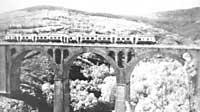
In any case, it is necessary that the properties of durability of the products used are made more beneficial for us and that they come together with a single objective: to shorten the maintenance; that is, the locomotives that are only incorporated to the workshop after 3 million kilometers, the cars that enter after a million kilometers and the wagons that will be formed once in their life.
C) Environment
This transport system, in front of its competitors, is a good friend of ecological science, taking into account its safety, energy consumption, pollution and noise.
1.- SecurityThe railways present a good or very good safety situation. The number of passengers killed per kilometer and one billion passengers is:
1.
Aircraft (ICAO Statistics)
1.
Motor vehicles (CEMT Statistics)
Services Services Services
Railways (UIC Statistics) |

But this one also has its back. The media affects more the accident than the railroad, and alter the public trial much more. We have become accustomed to road deaths and their pressure is never revealed in national accounts.
The self-sufficiency that the railroad has given us over the years demands that any technical advancement work at least with the same security. Even more so when the competitive system is improved. The aviation sector continues, providing airports with increasingly complex and safe equipment. The roads also advance, despite the increase of traffic, the most accidentally maintained and in absolute numbers. The railway situation in the transport of hazardous materials is solid.
States recognize less and less risks to the road and apply this type of regulations (RID, etc. ). ). The railroad cannot forget it. Therefore, safety on the railways tends to weaken in recent times and not to be fascinating with previous victories. There are still too many accidents in the pasoniveles. The remedy, of course, is expensive: remove or place automatic barriers. Road maintenance services are sometimes involved but not at the required level.

In more general terms, the automation of railways is often carried out with greater security, although it is not possible to establish a previous rate. BART, however, has shown that in the electronic systems and inside the crystals can also store failures, so it is necessary to introduce a new logic in the verification and packaging system. Therefore, the safety of the electronic systems is in the efficiency of the control tests, since from now on, for example, to speak of the own safety of the integrated systems that have the microprocessors, it does not make sense.
2. Energy consumption and pollutionIn the transport of people, the majority that has the railroad is huge and, of course, with the exception of buses. In this area the figures are little discussed and indicated in the following table in pGB (equivalent grams of oil) per passenger and kilometer:
Although the truckers would prefer to go with him the railroad against the cars, the sector of the railways has realized that the cars or the cars have passed by their enemy. Every customer of train, before, now and after, has been a tourist, is already and will remain.
For the railways, the services of the neighborhood and the interurban transports are obligatory for the society, and they represent a great energetic advance for the society.
But the railways begin to take care of themselves: their competitors, lately advance faster than him. For the year 2000, the cars anticipate an energy saving of 40% and the trucks approximately 30%, the planes 35% and the railways only 15%. This last figure seems insufficient, but how can all railways continue to improve their energy uses? Basically in two ways:
- Commissioning of fixed installations and circulating materials that require less energy: aerodynamics, lightness, static of the transformation organs, types of fuels (using the weight of fuel for diesel engines).
- Better use of media (electronic management of parks, routes, conductions, etc.)

It is also known that electrification, in addition to its own internal return, is in favor of the medium:
- Because it reduces the dependence of oil and is at least 100% for air routes to 20 years.
- Because it does not produce contamination of the means of transport. However, the road itself has advanced a lot (engine fuel and exhaust gases, roof deflectors, catalytic converters, etc.) And the advantage of the railways, already quite weak, will be reduced if things continue like this.
In general, the energy arguments are in favor of the railroad.
3.- NoiseThe fight against the noise of the means of transport has started for about 20 years in developed countries: It happened to the airports to begin, then came the season of cars and now there is way in the pupils.
For the same traffic, the railroad is quieter than the road, since although the sound emissions are comparable in absolute values, in the case of railways of railways are discontinuous while the roads are continuous.
d) Organisation of transport
As for the organisation of transport, the goods are mainly handled and the aim is to ensure that they are safe, fast and flexible. To do this, it is proposed to incorporate into the train block new specialized wagons (chemistry, crops, fruits or vegetables, container transport) and to adjust the size of the train blocks to the extent that it is viable for trade.
On the other hand, computer science can help a lot the organization of rail transport, both for the improvement of services and for its contribution to traffic.
e) Management
The railroad has its feet tied by chain: The labour force greatly increases costs. 60% in Europe in general. No entrepreneur could live the XXI. In the twentieth century with this handicap. However, solutions would be very different in different parts of the world.

In 1883, Sir Peter Parker, at the Congress of the National Railwaymen Association, stated that the offer of passenger and freight traffic is much better to compete against cars, buses, trucks and planes.
To do this, we propose to streamline, explain, comment and act throughout the hierarchy. Finally, the best guarantors of the railroad are innovation and technical progress. Today it is on the defensive, but it has to go through the attack and a factor for it is the fast speed. The future, therefore, depends on:
- Technical and commercial capacity by customer service. Welfare of the railways, especially of the customer.
- Production costs: labor and investments. To dominate not the workers of the railways, but them and the governments.




